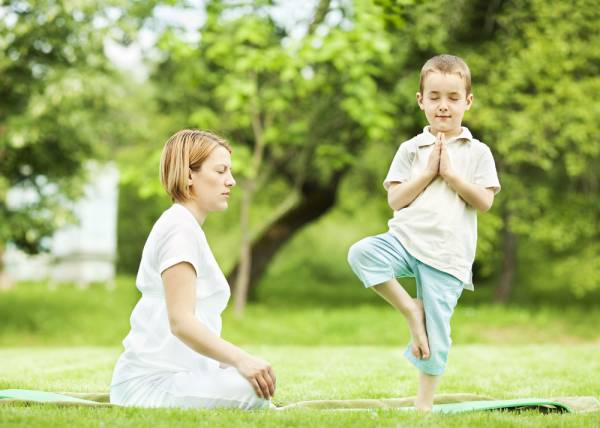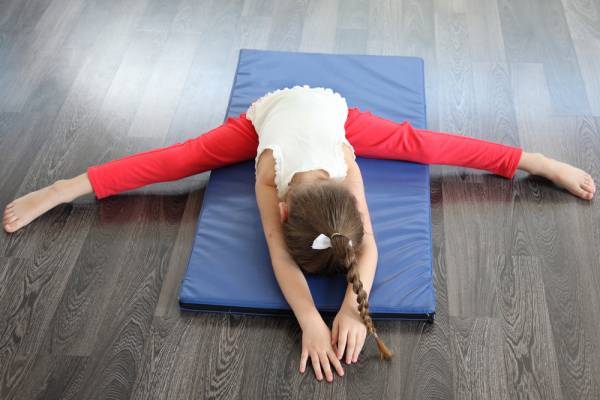Last week, I presented a two-hour interactive workshop on yoga and mindfulness to a group of 25 girls aged ten to sixteen from the YWCA. It was one of the hardest things I’ve ever done in my career as a yoga teacher. What language could I use to make mindfulness relatable? How could I demonstrate its benefits in any real way to these girls? How could I even hold their attention for two hours? Are there real benefits to yoga and mindfulness in youth?
As much as I struggled with these questions on the whole, the last question has a simple answer. Yes, there are abundant benefits in teaching yoga and mindfulness practices at a young age.
Benefit: Self Regulating Behavior
If a child goes to a behavioral therapist or counselor over the course of his or her youth, one of the first things the therapist will address is self regulation. In fact, many parents work to establish good self-regulating behaviors as early as infancy.
Self regulation includes good sleep habits, proper eating and personal hygiene, and self-soothing behavior for challenging emotions. Mindfulness experiences help a young person become more aware of why he or she feels a certain way. This awareness can be paired with techniques to regulate feelings to create a better outcome.
Exercise: Self-Regulation Techniques in Youth
- Ask the group or individual to name things that cause stress in life. Make a list of the things named.
- Have the group or individual come to a seated position with the eyes closed or lightly open looking at the floor. Some children will not be comfortable with eyes closed.
- In round one, give instructions to think about the word you say as completely as possible. Have the group or individual think of memories, feelings, experiences, or images associated with the word. Read through the list, pausing for about thirty seconds at each word.
- In round two, give the same instructions, but also tell the group or individual to take a full, deep breath after you say each word. Pause to allow a full breath at each word as you read through the list.
- Ask the group or individual about the experience after the exercise is complete. Most will report feeling more relaxed, calmer, or less anxious in round two. Ask how this may apply to other situations.1
Benefit: Increased Attention Span or Ability to Focus
Young people often become easily distracted by surroundings and interruptions. If you ever present to a group of young people, you will notice the varying array of attention through the group. Some will focus intermittently, some not at all. Mindfulness can help a young person learn to be aware of distractions without actually becoming distracted by them.

Exercise: Teaching Youth to Focus
- Have the group or individual stand up. This is a great thing to do if you need to bring the attention back to the presentation at any point.
- Teach tree pose. This is a simple, straightforward balancing pose. With children, allow them to interpret the pose as they would like.
- Instruct the group or individual to hold the pose on one side for thirty seconds to a minute. Have them count the number of times they fall out of the pose.
- Pause in between rounds and offer a simple mindfulness practice. Have the student(s) stand tall with the feet apart and knees slightly bent. Allow them to close or half close their eyes, but turn their other senses outward. Help them seek out distractions such as sounds, smells, the feel of the air on their skin, or other outward experiences. Bring them into awareness of as many different elements as possible in a soothing, simple way, without focusing too much on any one element.
- Instruct the group to repeat the tree pose once again, holding for the same amount of time, and counting the number of times they fall.
- Ask which round was more successful. Typically, students can balance for a much longer time after the simple meditation. Ask how they may incorporate this into their lives.
Benefit: Greater Embodiment Experience
Embodiment should be talked about far more when it comes to self-esteem, body image, and general sense of self. Embodiment is the awareness of what it is like to exist in your own body with a strong acknowledgment that you are made up of more than your body.
Embodiment has many benefits, a key benefit being less risk of injury when participating in physical activity. I have students come to my class who will be unable to follow instructions like “lift your left leg” or “straighten your right elbow.” This is not a judgment on their yoga skills, just a commentary on how disembodied our experience can be when we spend all day at work or school.
A second primary benefit of embodiment exists in the brain. The embodiment circuitry of the brain, i.e. the part of the brain responsible for moving and experiencing the body, acts like a damper on other areas of the brain. Namely, it quiets the default processes of repeated past experiences, and it calms the seeking behavior that may lead to pattern behaviors in youth. These behaviors vary from acting out to overeating, using drugs or alcohol, or even self-harm. When a person regularly engages in awareness of the body, he or she experiences a greater sense of satisfaction and a lower sense of need.1

Exercise: Teaching Embodiment to Youth
- Pause before beginning this exercise. Just give the instruction to come to standing and stand still.
- Stand at the front of the group and give the simple instruction, “Mirror my movements.” You may need to explain what mirroring is, but give as little instruction as possible.
- Start to move your body in a simple way: bend the torso, lift one or both arms, stand on one foot. Move slowly and explore easy ways you can move around.
- After a minute or so, ask if anyone in the group would like to lead the exercise.
- Give no real instruction. Simply allow the individual to take a role in deciding how the body can move. Many students will repeat the actions you presented. Some will create new movements you had not thought of.
- Encourage all who would like a turn to step up and lead the movements.
- Pause at the end of the exercise. Give the “stand still” instruction again, and notice the difference in behavior, stillness, and quiet.
- At the end of the exercise, tell the students, “You all just became yoga teachers.” Explain how moving the body allows you to become still and quiet after the movement is complete. Give some benefits of moving the body without mentioning weight. Talk about making the body stronger, more flexible, better balanced, and more resistant to injury. If you feel it is appropriate for the age group, you may mention that moving the body helps to quiet the brain.
References:
1. Moore, D. and Hopper, J., “Neuroscience, Mindfulness and Modern Yoga for Transforming Trauma.” Professional training, Kripalu Center for Yoga & Health. Lenox, MA, June 1-6, 2014.
Photos courtesy of Shutterstock.






